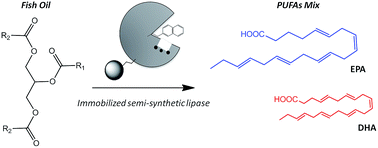Fabrication of heterogeneous biocatalyst tethering artificial prosthetic groups to obtain omega-3-fatty acids by selective hydrolysis of fish oils†
Abstract
The active site of lipase from Bacillus thermocathenolatus was selectively modified with allyl and naphthyl chains at different positions. Lipase immobilization and selective tethering of a naphthyl side chain to its position 320 improve both the hydrolysis rate of fish oils and the selectivity towards the eicosapentaenoic acid acyl chains.



 Please wait while we load your content...
Please wait while we load your content...